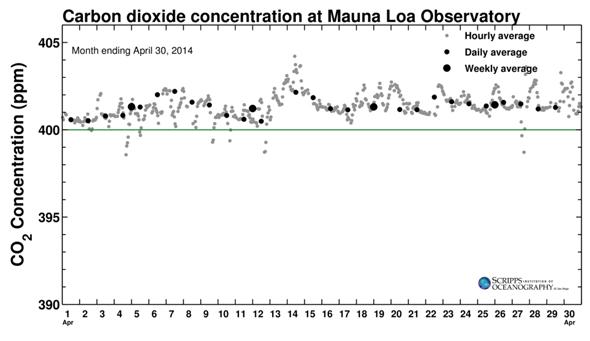Global warming has reached a new milestone, but congratulations are neither in order nor welcome.
April 2014 is the first month in human history where the average amount of carbon dioxide in the air topped 400 parts per million.
This was announced by the Scripps Institution of Oceanography at UC–San Diego, which monitors atmospheric levels of CO2 as part of the the Keeling Curve project. Last year, on May 9, 2013, the NOAO also announced that the CO2 levels had hit a daily average of 400 ppm for the first time in human history. The amount of CO2 in the air goes up and down slightly every day, month, and year, but over time the trend is up.
And less than a year after the daily average of 400 ppm was broken for the first time, we’ve had a whole month where the average topped that record. This is the highest concentration of CO2 in Earth’s air for at least 800,000 years, and possibly for far longer.
How much is 400 ppm? In more familiar terms it’s 0.04 percent. That may not sound like much, but it’s enough. Carbon dioxide is a significant greenhouse gas in our atmosphere, transparent to visible light but opaque to thermal infrared. The Sun’s light passes through the air and warms the ground, which then emits infrared light. But the CO2 in the air absorbs that light, preventing it from radiating away into space. There are a host of varying and sometimes subtle effects, but in general this adds heat to our environment, upsetting the delicate balance.
There are other greenhouse gases in the air, of course, like water vapor and methane. However, these are pretty much in balance, neither increasing nor decreasing over time. Human beings have been increasing the amount of carbon dioxide in the air, though, for over a century now … to the tune of 30 billion tons per year, 100 times as much as all volcano eruptions combined. Unlike methane, which breaks down quickly, CO2 sticks around. There are some places where it can be absorbed, but they cannot keep up with the amount we’re pouring into the air by burning fossil fuels.
And that’s why the Keeling Curve keeps going up.

Photo by Scripps Institution of Oceanography, UC–San Diego
But hey, if you don’t like bad news, just stick your head in the sand, like global warming deniers do. Taking their cues from Rupert Murdoch, they’ll tell you that warming isn’t happening. Or it’s happening, but it’s not due to carbon dioxide emissions. Or it’s happening, but it’s not our fault. Or it’s happening, it’s our fault, but it’s nothing to worry about. They do seem capable of believing six impossible things before breakfast. Maybe next they’ll deny carbon dioxide even exists.
Or, we can accept the hard reality: It’s real, it’s our fault, and it’s very definitely something to worry about. And we need to take it seriously, now.
